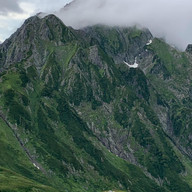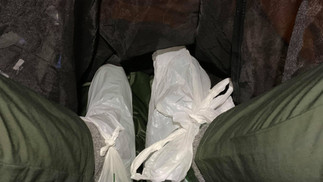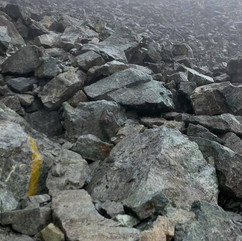Access: Shinano-Omachi Station --> Ogisawa Terminal --> Kurobe Dam --> Tateyama Ropeway --> Murodo Terminal

Mountain: Tsurugi-dake 剱岳 (2,999m)

After over 10 years of hiking in Japan, I have experienced a variety of challenges across a vastly wide range of mountain shapes & sizes. For every hike, there are many factors that must be considered: total altitude, trail elevation, steepness, location, course length, technical grade, etc. So from the many mountains I have hiked, I have realized that some are much more challenging in one of these aspects but not others. For example, Mt. Fuji in the summer has the highest total altitude and also a fairly long course length, but it is generally not considered to be a technical hike and is much less steep than many other trails. As such, supplies, altitude & weather changes are the biggest factors to prepare for. Other trails like Mt. Myogi or Mt. Tanigawa are both under 2000m and have a relatively short course length, but both mountains are incredibly steep and require technical skills in order to ascend the many chain walls along their jagged and rocky ridge-line paths. Lastly, courses like Mt. Kinunuma or Mt. Amagi are neither steep nor technical, but are simply very long, remote trails which require some endurance and proper provisions. And then there is Tsurugi-dake, the prized sacred mountain located deep in the Kita (North) alps. It is referred to as "Japan's most dangerous climbable mountain", as it is the sum of all these challenging factors. In other words, if the other mountains are a test of one's various hiking abilities, then this mountain is the final year end exam.
Scoping out the trail in 2020
Unlike other mountains, I decided it would be safest to do some reconnaissance on the trail before attempting the full climb. So, in the summer of 2020 I went traveled out to Murodo to see what the area was like. It was a day long journey through the many trains, buses, and cable cars before I could finally arrive. I packed a tent and sleeping bag that I had bought years ago. These items were made for leisure camping rather than mountaineering, and as such they were quite heavy, making it very difficult to carry in my backpack, which was weighing in at 28kg! This was my first big error. It was about an hour walk from Murodo to Raichozawa camping ground, and with my ultra heavy bag every step was a challenge. To further illustrate the fact that this mountain was simply not it's own world, and challenge of what was to come, along the way to the campground I passed by Jigokudani (地獄谷) and Chinoike (血の池), which translate to "Valley of Hell" and the "Pond of Blood". The "Valley of Hell" is a naturally active volcano and along the path there are signs warning of sulfuric gas. Just as I started walking along the trail, the lights lit up signalling clouds of gas were coming. I ran as fast as I could to pass by the danger and wore a mask to protect my lungs from the toxins. Shortly after, I arrived at Raichozawa campground, below the base of Mt. Besan. Having passed the various hells along the way, watching sunset from this campground felt like heaven. But even from here, the mythical Tsurugidake was obscured from view.

View of Mt. Bessan from Raichosawa Campground
As soon as the last light disappeared from the horizon, the temperature began to fall drastically. Even in mid-August, where the daily heat index was well above 40 degrees in central Tokyo, it had dropped to a mere 12 degrees at the base camp. I buried myself in several layers of clothing, and did my best to keep warm during the night. I got up the next morning just before daybreak, and quickly made my ascent along the slope of Mt. Bessan. I left the tent as it was so I wouldn't be too overburdened with gear. Still tired from carrying everything the evening before, I pushed upwards for about 2.5 hours until I reached the Tsurugi-gozen hut, and arrived just as the sunlight came over the top of the mountain. From this viewpoint I could see all of Murodo and the path that I had taken, but then I turned around and saw the inner valley of the Kita Alps, and there in the distance I could finally see the legendary mountain.

Tsurugidake from Mt. Bessan
From this path it was about a 90 minute scramble down the rocky slope until reaching the true base camp of the mountain. Here I was able to fill up on some water, and decided to see how far I could actually get towards on the mountain. I continued onwards up the steep and rocky slopes until I reached Maetsurgui peak. At this point the heat and muscle soreness from the heavy backpack had taken a toll on me, as well as having exhausted my food and water supplies. Since I still had a long ways back to my tent, I decided it would be wise to turn back. It was another 4~5 hours until I made my way back up & down Mt. Besan, finally passing over the river by the campground just as the sun began to set.
A full year of training for Mt Tsurugi
Now I knew the challenges I would be up against, and had a better understanding on the course layout. I would spend the next full year training to take on this monster. There were five areas of improvement I needed to focus on.

The first area to improve was leg strength: I needed to be able to reach Maetsurugi and still have enough leg strength to push on for another 2 hours. I trained for this by continuing my outdoor stair training. I moved around a few times over 2020/2021, so the first thing I would do is search for a new steep flight of stairs. In Hakone, instead of stairs, I would climb up the steep hill from Gora station to a hidden temple above Souzan station almost every day - a road so steep most people take a cable car. While living in Fussa, I found a shrine atop a steep flight of stairs.

The second area to improve was back strength for carrying capacity: my backpack was far too heavy during the last hike, and my back muscles became too exhausted even though I didn't take all the gear with me past the Raichozawa campground. I trained for this by gradually adding weights in my backpack during my morning runs. In Hakone, I climbed several "smaller" mountains with a 12kg dumbbell in my backpack. I eventually bought a 10kg weighted vest, but it put a lot of pressure on the shoulders, so I had to be careful not to overuse. In addition to strength, I also had to find ways to lighten my carrying load. I sold my old tent and sleeping bag, and replaced them both with ultra-light versions.
The third area to improve was endurance: the course on Mt Tsurugi is long and exhausting. So, I had to push myself on many trails that would test my perseverance. Hakone was an excellent area to train for this. Many days I would embark on long hiking journeys, such as hiking from Hakone-Yumoto station all the way to Otome Pass. I hiked Mt. Fuji again in the summer as well as Mt. Tanigawa. But where I really gained stamina was Mt. Myojingatake in Hakone. My first hike to that mountain was beyond exhausting, but I kept going back there, and eventually I climbed it with that 10kg backpack.
The fourth are to improve was technique: Asides from improving standard hiking techniques, I had to practice actual wall climbing and using a harness and carabiners. I did this on other small mountains as well as chain sections near my apartment. I also did lots of pull ups and shoulder press in my mini sharehouse gym.

The last and most important area to improve was mental fortitude: the last section of Mt. Tsurugi, known as the "Kani no Tate bai"(Vertical crab crawl) is a 90 degree climb up 100m of rock face above a death-defying drop. It is here when all the human instincts kick in - fear can take over - and that is the ultimate enemy on a mountain. I had felt this several times before on other mountains, and I wanted to make sure it wouldn't happen at such a critical place. So in early July 2021, I decided to challenge Mt. Tanigawa again. When I climbed up it's vertical jagged ridgeline for the second time, I surprisingly didn't experience any dread. Then in early August, I challenged myself on Mt. Nokogiri in West Tokyo which pushed both my endurance (due to the humidity), and also had a small chain rope section. My hikes on Mt. Fuji and Mt. Nyoho also helped strengthen my mindset. I also bought a climbing harness with two carabiners (which I used on Mt. Myogi the year before), so that added to the safety.

Climbing Mt. Tanigawa 6 weeks before Tsurugidake
The most epic of hikes begins
Having waited through almost the entirety of the summer, with almost every weekend being a typhoon or some other weather phenomenon, I saw a small window to climb near the end of August and took it without hesitation. This time, I carefully chose every item in the backpack, having it weigh in at just under 15kg. Still very heavy, but I managed to shave off 13kg from the previous year. I then took the same long route to Murodo station, and even ran through Kurobe Dam to catch an earlier cable car, arriving just before 2pm. Based on my previous experience in the area, I knew that starting the hike from Raichozawa campground would be too exhausting for one day, so my goal was to make it to Tsurugisawa campground on the other side of Mt. Bessan. There was one big problem, following right behind me was a heavy dark storm cloud.
Caught in a heavy rainfall
At 2:30pm , just before I arrived at the first campground below Mt. Bessan, the & wind rain started coming down fast and heavy. I quickly ran to the campground toilet for shelter. Within minutes, there was a group of wet and cold hikers hiding in the the little room as it showered intensely outside. Thirty minutes later it didn't look like the rain was going to stop anytime at all, and seeing the campground begin to flood, it started to looked like all hope is lost. Even if it wasn't going to rain the next morning, there was no way I'd have energy to hike both Mt. Bessan & Mt Tsurugi in one day, so climbing Mt. Bessan now was the only option. I we waited, two hikers decided to retire back to Murodo station. Another hiker decided he would just camp at this location since it was getting late. The rain finally let up at 3:45pm, and I saw my one and only chance. I had about 2.5 hours of sunlight left, and I'd have to go up this wet and slippery mountain with a chance of getting caught in the rain half way up. It was a daunting challenge, I wasn't ready to give up just yet. I pushed forward and with all my strength and speed and somehow made it to the top of Mt. Bessan in just 75 minutes! - a huge improvement over my climb the previous year, and in much worse conditions. Taking little rest at the top, I immediately descended down towards the next campground. Thankfully, as I entered deeper into the hidden valley on the other side of the mountain, the weather began to clear up and the great Mt. Tsurugi revealed itself just as I was a few meters above the campground. There, I set up my tent, changed out of my drenched clothes, and buckled down for the cold night.
A night trek over an icy & rocky terrain
Throughout the night, wind and rain battered against the tent until finally letting up around 11pm. At this point the temperature dropped significantly, and was around 8 degrees or less. My sleeping bag was warm, but I could still feel the cold ground below me. Several strong gusts of wind blew out the tent pegs, but I had also pinned it down using some small rocks. I got up at 3am and began assembling my backpack. Since my hiking shoes were soaked from the previous day, I put on two layers of socks, and wrapped each foot each in a plastic bag. In the cold windy night I put away my tent and was all set to go by 3:45am.

3:15am at Tsurugisawa Campground
There was no moonlight during this walk, so the path was a bit hard to follow. Along the way I came across a large sheet of snow and ice which I had to cross to get to my destination. I had not expected to be climbing a snowy ridge in August. The fact it was still pitch black out and wind added to the danger, but I knew this was just a small taste of the challenges to come. I carefully crossed the icy road and the rocky terrain, and arrived at the mountain cabin by the base of Tsurugi, just in time to view the immaculate sunrise. There, I filled up on water and drank my fare share to ensure I would be well hydrated not just for the climb up, but also the descent. I ordered a cup of coffee before heading out. I was expecting some cheap instant coffee, but was delighted to be handed a fancy porcelain cup from a freshly steeped pot. After my luxurious coffee break, it was time for the real climb. The sky lit up a golden hue as I began heading onwards, although I knew this perfect weather would probably not last.
Race against time and rain
For the first hour, everything was perfect. I knew the route and although steep, it was nothing I couldn't handle. The early sun lit up the sky like fire and the scenery around me was nothing short of breathtaking. But in the distance above, I could see another thick fog. It wasn't long until I was heading up the long and steep rocky slope below Maetsurugi. This part of the mountain is very similar to Tanigawa, and both times I had to carry up a heavy backpack. There are a couple sections here with chains, but they are mostly for additional support and not really necessary. By the time I finally arrived at the first peak, the strong winds and mist had completely enveloped the mountain. This was as far as I had made it in 2020, and despite the odd weather conditions, I still felt surprisingly energetic. I had hardly drank any water or had any snacks until this point, and was still confident in my strength to continue onwards. The path the led onwards was shrouded in mysterious fog, which may have been for the best as I was not discouraged by seeing the long and painstakingly journey still to go.
Here be dragons
I was now venturing into the my own uncharted territory. Every challenge section of the mountain trail was numbered, and from here they were written in bold, with the ninth section being they infamous cliff. There were four sections of notable risk that I had to prepare myself for - combined with the wind and fog, this is where keeping a cool mental state was also necessary.

5 & 6) Maetsurugi Cliff (The BRIDGE)
Not long after moving past the Maetsurugi peak, I came across a section where a tiny narrow bridge was bolted in between two rocks above a gorge. Alongside one of the rocks was a chain rope that moved horizontally around the giant boulder. One slip here and I'd fall good 500m. It was time to bring out the harness and helmet. As I moved along side the cliff I did my best to focus only on the rock and avoid the seemingly bottomless drop just to the right of me. I dragged one of carabiners along the chain for extra saftey, and thankfully made it along the edge without any incident. I continued along the next ridgeline which was quite a calm path until I reached the next section.
7) Heizo-no-atama (The FIN)
I then saw another chain wall ahead of me. There were some metal bolts deeply secured into the rock face to be used as hand grips & stepping platforms as the hiker ascends the wall. I took one careful step after another for two and a half minutes until I reached the top, and then to my shock, I realized that the chain continued down a straight cliff on the other side. Also, at this critical moment I heard the man behind me yell. I looked back but saw he was fine. A moment later I heard him yell and curse again, once again thinking he had slipped. As I continued to make my way down, the odd yelling continued and I realized this hiker most likely had some form of tourettes, and I was sure the stress of being in such a perilous location was sending it into overdrive. Still, I focused on the wall until I reached the bottom of the chained area. But it wasn't exactly over yet.

8) Heizo-no-koru (The LEDGE)
Here was another horizontal walk across the mountainside, with NO chain for support. However, the path was slightly wider than the 6th section, but I still had to be careful of my heavy backpack throwing me off balance. There was a small chain section at the end of the path, but nothing compared to before. Here, I passed above another large sheet of snow and ice. Amazingly I saw a group of hikers ascending the sheet decked out in full winter gear. They seemed to be part of some mountaineering school. There was also a member of the Japan Self Defense Force climbing the trail. I continued the route, and saw a couple staring in awe and horror above them. I looked up and realized I had finally arrived at...

The Wall of the Vertical Crab
[9) Kani-No-Tatebai カニのタテバイ]
I had finally arrived at the infamous ninth section: The Wall of the Vertical Crab - 100m of pure exposed rock face at a steep 90 degree angle, with nothing but a couple bolts and a chain rope to hold onto. To further exacerbate the already daunting climbing conditions, the moment I finally approached the wall I could feel it start to rain. But, I was well beyond the point of going back, so I put my left first foot onto the rock, grabbed the chain rope above me, and began the climb. It was one slow step after another. I took extra time to ensure my was clipped into the chain. Because the rope was vertical, I had to make it to each "knot" before I could resecure the harness. There was a line below me, but I wasn't going to let that make me feel rushed. There was one part where I couldn't for the life of me figure out where to put my foot, but an old hiker below me in an orange helmet pointed out the spot, and I was able to push upwards. On top of my own weight, I also had to support my 30 pound backpack, which really pushed all my muscles to their limits. Finally, after 13 full minutes dangling on the side of the cliff, I finally had made it to the top of the ridge. After a short breather, I continued to push forward, eager to see that summit. I turned the corner, and found another chain rope dangling down another rocky cliff. That's right - there were two sections to it! However, this section was at a bit less steep angle. There was only one spot that required me to do a full pull up, which was quite exhausting, but after that it wasn't any big problem. Knowing the worst was behind me, I continued onwards. In the final stretch to the top, I passed by many hikers that gave me words of encouragement "You're almost there - only 10 more minutes!"- I was only 10 minutes away about 4 times for the entire final 40 minutes to the top. But eventually, I did arrive at the rocky summit shrine of at the top Mount Tsurugidake. There were quite a number of climbers at the top. After taking my picture and a short 5 minute snack break, I decided to not waste any time as I still had to make my way down.
Descending the long "Early Moon Ridge"
[Hayatsuki-One 早月尾根]
There was a man at the top of the mountain with an old straw farmers hat who was collecting garbage. I asked him for directions to the Hayatsuki Ridge route. He told me he was going down the same path, so I joined him on the descent. His name was Kaneda, and he worked at a sake brewery in Ishikawa prefecture. He told me how he wanted to take a picture of his saké at the top and so he was disappointed to not get a clear sky, and was actually considering hiking it again just for that photo. The first hour down the ridge still had some treacherous chain sections, where I had plenty of opportunities to plummet to my early demise. Thankfully, I managed to keep my balance and cool. The most challenging part was a ledge called Kani-no-Hasami (The Crab Scissors). Not too sure what it is named that way, but it was a similar horizontal climb around a narrow ledge like the Matetsurugi Cliff. It was the last section where I felt my harness was necessary, although I wasn't too sure, so I kept it on for a while more.

About an hour later, there were still small sections with chains, but the level of difficulty was no longer maddening, and so after a well earned rest, I put away the helmet and harness. At this point, the sun had started to come out as well, and I could see the beautiful views of Murodo station in the distance, as well as the long, long journey ahead of us. It was still another 3 hours of steady hiking downwards until we finally reached the one and only mountain cabin. There, I filled up on water, drinking at least 2L while there, and then buying another 2L for the journey downward. Already exhausted beyond measure, I had considered just setting up camp there and resting, but I really wanted it to be over and done with so we pressed onwards. My back was killing me at this point, and since Kaneda wanted to keep up the pace and reach the bottom before nightfall, he kindly offered to switch backpacks. I was hesitant to accept at first, but he really didn't seem tired, so I let him try for a bit. His own bag was virtually weightless, which explained how he was able to climb so nimble near the summit. Even with the lighter gear, as we moved downward, the weather got hotter and our bodies continued to get exhausted. 4 hours after departing from the mountain cabin, we finally reached the end of the trailhead, moments before it was too dark to see. All in all, I had climbed from 3:45am to 7:00pm with little rest. I got a ride into the city and rested up in a cheap business hotel. It took a full 5 days to recover after that journey. (And the friendly Kaneda actually hiked Mt. Tsurugi one week later and got his precious sunrise photo with his bottle of saké)
The final word - Tsurugidake is a Mountain of Risks, Challenges, but most prominently, with all its perils, Tsurugidake is unapologetically - a Mountain of True Adventure. It was an end goal that I slowly worked towards over 2 years, slowly building up strength and meticulously researching and preparing every aspect of the course, especially since embarked on this journey alone. It showed me that with enough training and determination, even a colossus can be conquered. And after a short break to enjoy this victory, write a blog about it, etc., the only question that remains is - where do I go from here?

Tsurugidake from Tsurugisawa Campground





























































































Comentarios